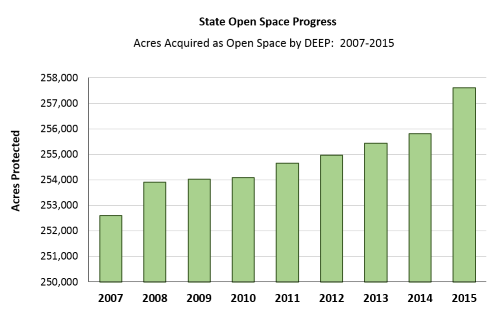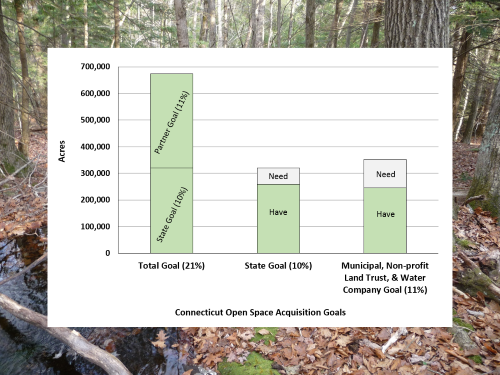Connecticut's Comprehensive Open Space Acquisition Plan
The 2016-2020 Green Plan
From its sandy shoreline, through open fields, and to mountain forests, Connecticut boats diverse and scenic landscapes. Pressures from land development and impacts by climate change threaten the integrity of Connecticut’s special places. Protecting key lands as open space is a part of sound natural resource and watershed management. By protecting the state’s most important areas, present and future generations can enjoy benefits provided by intact, functioning natural resource lands, such as safe drinking waters, biodiverse habitats, and plentiful outdoor recreational opportunities.
The Connecticut Comprehensive Open Space Acquisition Strategy (Green Plan) guides the efforts by the Department and its land conservation partners to meet a goal of conserving 21% of Connecticut's land base as open space by year 2023, as set by section 23-8 of the general statutes.
As of June 30, 2019, the Department estimated that 508,718 acres, or 75.5% of the total open space goal, has been protected by the Department and its land conservatio Partners. DEEP and its Partners need to acquire or protect an additional 60,392 acres and 104,100 acres of open space to reach their respective shares of the goal.
Download the Green Plan
Complete Green Plan
The current Green Plan contains acquisition priorities, targeted acreages, and State program actions to protect specific lands identified as capable of providing certain services, for example buffers to climate change, critical wildlife habitats, and recreational trails. The plan can be viewed or downloaded in its entirety using the following links:
Green Plan by Sections
-
The Action Strategy section includes the Executive Summary and identifies priority land cover types and State program actions for open space conservation.
-
The Background section provides readers with additional information on existing open space in the state, funding programs, natural resource and recreation topics, and more.
-
The following are links to Background Subsections:
-
The Appendices provide supporting data and documents on the Green Plan.
Background & Revision
Background
Recognizing the threat of loss of environmental resources to changes in land use, the General Assembly set a goal of protecting 21% of Connecticut’s land base by year 2023 for public open space purposes. With a total of 3,205,760 acres in Connecticut, 673,210 acres must be protected to meet this goal.
Connecticut General Statute section 23-8 set open space acquisition targets for the State and its land conservation partners (municipalities, non-profit land conservation organizations, and water companies):
- 10% (or 320,576 acres) is to be acquired and held by the State of Connecticut (DEEP)
- 11% (or 352,634 acres) is to be acquired and held by DEEP’s land conservation partners.


Revising the Green Plan
DEEP worked for several years on revising the previous Green Plan (2007-2012) in an attempt to improve upon past plans, add features to the plan, make the revised plan action-oriented, and set five-year goals, required by section 23-8 of the general statutes.
In 2016, DEEP made a draft revised Green Plan publicly available on its webpage and opened a public comment period. Preliminary versions of the revised Green Plan were also shared for review with the State Office of Policy and Management, Department of Public Health, Agriculture, Council for Environmental Quality, and the State Natural Heritage, Open Space and Watershed Land Acquisition Review Board.
Plan content revisions were made to address public comments and comments received by the above referenced agencies. The result of this interdisciplinary and transparent revision process is a state planning document that DEEP believes is far improved and more meaningful to a greater number of land conservation planners working in the state.
Stay Involved with Your Open Space Plan
By statute, the Green Plan is updated every 5 years. The Department needs to hear from all stakeholders in order to develop a planning document that will be the highest value for the State, municipalities, regional planning agencies, land conservation organizations, and the public.
How can the Green Plan be improved? Can it be implemented more effectively? You are encouraged to submit your comments via e-mail or by postal mail to:
CT Department of Energy and Environmental Protection
Land Acquisition and Management Unit, 6th Floor
79 Elm Street, Hartford CT 06106-5127
Content Last Updated September 12, 2019

